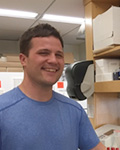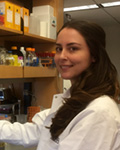Current Lab Personnel
 | Joerg Graf, PhDProfessor and Assoc. Dept. Head for Graduate Research and Educationjoerg.graf@uconn.edu The microbiome is critical for the wellbeing of all animals. I am interested in deciphering the interactions of the microbiome with the host animal and of the members of the microbiome. My team employs a wide range of complementary approaches, including next-generation sequencing, molecular genetics, microscopy and computational approaches to investigate the microbiome. We employ 16S rRNA gene deep sequencing to detect pathogens in aquaculture settings and use comparative genomics to identify colonization and virulence factors of Aeromonas. |
 | Susan JantonResearch AssistantI support the USDA, NSF, NIH and UConn funded research project in the lab. Besides providing general support, I operate the epMotion, QIAxcel and QIAcube. My research project focuses on the determining the leech immune response to the colonization of different bacteria. |
 | Jeremiah MardenPost Doctoral Fellowjeremiah.marden@uconn.edu I am interested in identifying factors that allow Aeromonas to function as a symbiont in the gut of the medicinal leech. I am currently studying two Aeromonas secretion systems that appear to be important in this symbiosis, the type three and six secretion systems (T3SS and T6SS). Our lab previously demonstrated that an Aeromonas T3SS, which injects effector proteins into eukaryotic cells, is important for its survival in the leech gut. We are trying to understand the range of T3SS effectors present in Aeromonas strains and determine which are required for this symbiosis and for interacting with other eukaryotic cells. The T6SS allows bacteria to puncture the membrane of neighboring cells and inject a range of effectors that can kill the "prey" strain. This system is found in many bacteria and is currently a topic of great interest in microbiology. Our lab previously isolated a transposon mutant in a T6SS-related gene that was significantly attenuated in its ability to colonize the leech gut. We have shown that the T6SS allows Aeromonas to antagonize other bacteria and are actively trying to assess the function of this system with respect to gut symbiosis and in interactions with other bacterial species. |
 | Emily McClureGraduate StudentIdentification of microbiota in the New England medicinal leech, Macrobdella decora: We are using Illumina MiSeq deep-sequencing to identify bacterial taxa, FISH imaging to describe localization, and Qiime/R/Python community modeling and statistical analysis. Development of gut microbiota in Hirudo verbana: We are now using deep-sequencing methods to determine the actual community compositions during the hatchling and juvenile life stages of H.verbana. Flavobacteria detection and identification: a ddPCR method was developed to quantify Flavobcterium columnare and F. psychrophilum in natural water samples. This method is being developed because of its extreme sensitivity, reproducibility, and utility as a quantification method. |
 | Lidia BekaGraduate StudentI study the effects of low levels of antibiotics present in the digestive tract of the medicinal leech on the symbiotic Aeromonas population. My research aims to link a rise in the antibiotic-resistant bacteria in the leech to reports of infections occurring in hospitals where leeches were used on patients. For another study I use next generation sequencing to determine the presence or absence of fish pathogens, Flavobacterium columnare and F. psychrophilum, at commercial trout farms. This research aims to determine the source of the pathogens when a disease outbreak occurs. My research questions rely on high quality genomes and so I also make use of Nanopore sequencing technology to improve Aeromonas and Flavobacterium draft genomes by combining short and long reads in hybrid assembly methods. |
 | Todd TestermanGraduate StudentI am a PhD student in Dr. Graf’s lab. I am interested in microbiome research as well as host-pathogen interactions. I spend most of my time working on a USDA-funded fish pathogen project. We analyze the microbial communities on and around the rainbow trout in commercial aquaculture facilities using 16S rRNA sequencing. We hope to gain insight into the causes and factors affecting large-scale disease outbreaks within these facilities. We are also developing genomic tools for the detection of specific fish pathogens of interest. |
 | Ahmad HassanGraduate StudentI work on the characterization of Puerto Rican bats oral and rectal microbiome using 16S rRNA sequencing of V4 gene on Illumina MiSeq platform. Moreover, to understand how microbiome beta diversity vary among Puerto Rican bats based on taxonomy, diet, sex, and body size. Finally, identify possible zoonotic microbes such as Leptospira, Rickettsia, Bartonella, or Coxiella. |
 | Abhishek YadavUndergraduate Researcherabhishek.yadav@uconn.edu |
 | Amy LinUndergraduate Researcheramy.lin@uconn.edu |
 | Daniel GoldenUndergraduate Researcherdaniel.golden@uconn.edu |
 | Emily LaMarreUndergraduate Researcheremily.lamarre@uconn.edu |